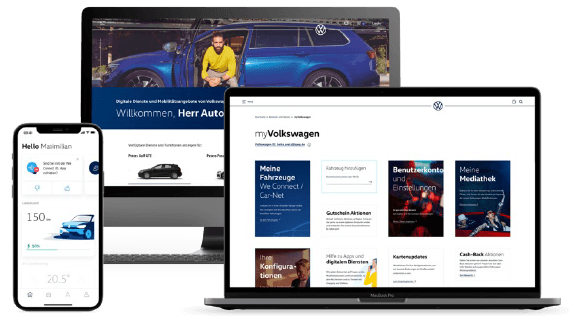
Scalable international content
Agency for international content management
Expertise that drives results:
- Specialists in international content management and maintenance
- Strategic consulting on content processes, systems, and tools
- Content creation, translation, and localization for your website or app
With our expertise in international content management, we help companies create, translate, and manage digital content for global target markets. Our interdisciplinary project team works closely with you to design end-to-end processes for scaling your content internationally. We support you with project management, implementation, and the integration of content management systems (CMS) as well as localization tools.
“We use proven processes and smart tools to help companies go global. And we always keep one thing front and center: the needs of local users in every target market.”
WHY INTERNATIONALIZE YOUR CONTENT?
Some key facts and figures
73%
of users prefer to shop in their native language
Studies show that most online shoppers are more likely to buy from websites in their own language.
90%
only use websites in their native language
9 out of 10 internet users prefer to browse websites in their mother tongue whenever possible.
30%
more SEO power with multilingual websites
Sites optimized for multiple languages benefit from significantly stronger organic traffic.
52%
of all websites are English-only
But only 16% of people worldwide speak English. Local content gives you a clear advantage.
Basics
What international content management is all about
What does international content management involve?
International content management includes all the tasks of classic content management—such as content strategy consulting, selecting the right formats, implementing a CMS, performing content audits, and of course creating, optimizing, and publishing content of all kinds. On top of that come the international aspects: Which target markets are you addressing? What linguistic and cultural factors need to be considered? Are there differences in user expectations across markets? What does that mean for your brand messaging? How does it affect your content and what needs to be adapted? We are here to help you find the right answers.
How qwp supports your international content management
We support your international content efforts by building efficient processes and working with local experts in dedicated project teams. Native-language translators adapt your content to the cultural and linguistic context of each region, ensuring it meets market-specific customer needs. We also analyze content performance across languages and markets and provide practical optimization advice. That’s how we help you build a global presence and drive international growth. We also support you with CMS solutions and content workflows and offer CMS trainings and process workshops .
WHAT'S INCLUDED
Key elements of international content management
- Content strategy: Depending on business goals, channels, and target audiences, the right content format is selected. An editorial plan defines what gets published, when, and in which market.
- Content workflows: Structured workflows ensure that multilingual content is created, managed, and organized efficiently.
- CMS implementation: When introducing or operating a content management system, we consider requirements like usability and scalability from the start.
- Content audit: We analyze your existing content and identify ways to improve it. Content audits provide insights and recommendations for future content development.
- Content creation: Based on the editorial plan, relevant topics are researched and transformed into high-quality content for each target market.
- Content optimization: We optimize your content for search engines (SEO) and continuously monitor performance to improve rankings and visibility in your key markets.
- Content distribution: Your content is published across relevant channels to maximize reach and engagement.
- Content maintenance: We help you manage and maintain multilingual content efficiently, including updates, translations and localizing content, .
What makes it complex
Requirements and challenges
What are the requirements for international content management?
International content needs to be tailored to ensure it resonates with different audiences and cultures. That’s why native-language experts don’t just translate your content, they localize it. Localization means adapting your content to the linguistic and cultural specifics of each target market. This includes things like currencies, date formats, units of measurement, public holidays, as well as visuals, colors, and design elements—always tailored to your audience’s needs and preferences. Your brand message also needs to remain consistent across markets while striking the right tone and creating the right impact in each language.
What makes international content management so challenging?
Managing and organizing multilingual content requires well-structured project management. Content maintenance in particular can be complex and time-consuming. Depending on your needs, you may need different versions of your content for each language and market (versioning). That content needs to be published in time, regularly updated, and constantly monitored to ensure it stays relevant for your audience. Coordinating across teams—possibly across departments, time zones, or countries—can also be a major challenge.
Technical requirements are another key factor: CMS integration and search engine optimization (SEO) must be adapted for each market and language.
Content management systems
What makes a good CMS
- Easy to use: Intuitive interfaces that let users create, edit, manage, and publish content with ease.
- Flexible: Supports different content types and formats, e.g., text, images, video, interactive elements, and adapts to your needs.
- Scalable: Handles growth in content and traffic without compromising performance.
- Secure: Protects your content and user data with encryption, access controls, and regular security updates.
- Seamlessly integrated: Connects with tools like CRMs, marketing platforms, and e-commerce systems.
- Targeted: Enables content delivery based on user data and behavior—tailored to the needs and interests of specific audiences.
- Data-driven: Tracks content performance with built-in analytics to improve visibility and rankings.
- Fully supported: Comes with documentation, training, and responsive help when you need it.
ORGANIZING MULTILINGUAL CONTENT
CMS, PIM, and key-value systems – when to use which
Alternatives to content management systems
In addition to well-structured processes and workflows, choosing the right system is essential for scaling content internationally. Content management systems (CMS) allow you to create, manage, and publish digital content. But even the best CMS has its limits—especially when large volumes of content need to be adapted and published across many markets and languages.
One alternative is key-value systems—databases that work with key-value pairs. Each entry is assigned a unique key (e.g., a string in the code), which can be used to store and retrieve the corresponding value (e.g., a text element). This allows data to be managed and accessed efficiently. Tools like Phrase and Memsource are typical examples.
Phrase (formerly “PhraseApp”) is a cloud-based platform for managing translation and localization across websites, software, and digital content. Project teams can use it to set up multilingual content workflows, with a master language at the core and localized versions branching off.
For e-commerce platforms, PIM (Product Information Management) systems are often the better choice. These systems enable centralized management of product data, ensuring consistent communication across all sales and marketing channels.
What’s the difference between CMS and key-value databases?
The key difference lies in how the two systems store and manage data.
CMS platforms are designed to store, manage, and publish digital content like text, images, and video—typically for websites or other digital channels. Thanks to their intuitive interfaces, content can be created, edited, and published quickly and easily. Some CMS platforms also support version control, workflow management, and content analysis when needed.
Key-value systems, on the other hand, don’t store digital content in a structured way, but instead use key-value pairs to enable fast (technical) access to data. Compared to CMS platforms, key-value systems typically offer greater scalability and performance, as they allow fast read/write access even with large volumes of data.
Both systems serve different purposes but they can also be combined. Tools like Phrase or Contentful integrate both approaches: Contentful combines the high performance and scalability of key-value logic with the usability of a CMS, making it easy to publish content across multiple channels.
LEADING CMS PLATFORMS
What leading CMS platforms offer
- AEM: Adobe Experience Manager (AEM) is a cloud-based CMS that integrates seamlessly with other Adobe products. Its strengths lie in scalability and its ability to support complex websites.
- TYPO3: This open-source CMS includes features like multilingual content support, workflow management, and SEO tools. It’s highly customizable and supported by a large community which makes it ideal for midsize companies and organizations.
- Contentful: This cloud-native platform is built for developers and enterprises that need fast, flexible content delivery. With an API-first approach, it enables publishing to websites, shops, and apps across all digital channels.
- Magnolia: This Java-based CMS offers personalization, analytics, a modular architecture, and robust integration capabilities, making it well-suited for complex websites.
Trusted by companies across industries






All trademarks, logos, and brand names are the property of their respective owners.
The Experts in User Experience
Featured case study

Volkswagen website rollout
FAQ
Frequently asked questions
When do you need international content management?
What are the biggest challenges in international content management?
What does international content management include?
Which CMS platforms are recommended for international content management?

The Experts in User Experience
What sets us apart

UX
Expertise
Multimedia user experiences that drive satisfaction and boost conversions

Content Scaling
Know-How
Global rollouts and optimized localization thanks to efficient tools and workflows

Project Teams With Local Expertise
A global network of native-language content and UX professionals

Agile
Methodology
Fast, flexible, and effective implementation using SCRUM and SAFe
The Experts in User Experience
How we help you go further
Get in touch
Smart solutions, made for you.
Your users are our priority: in every piece of copy and at every touchpoint, across the globe. We help you optimize the user experience of your mobile apps, websites, or online stores. And scale your products and content internationally.

Brendan Reiswich
Business Development Manager
Phone: +49 30 30809311



